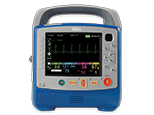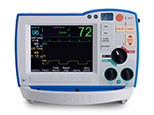Redefining Fast
Timely response is important for all patients at risk of sudden cardiac death. Streamlined automatic detection and treatment are critical to patient survival. For in-hospital use, the Hospital Wearable Defibrillator (HWD) is designed to provide continuous monitoring, rapid detection, and automatic treatment for certain life-threatening rapid arrhythmias.
In a typical situation, the entire event, from detecting a life-threatening rapid heart rhythm to delivering a treatment shock, occurs in about one minute. When the heart can be returned quickly to a perfusing rhythm, long-term complications can be minimized. Data on shockable rhythms shows that when response exceeded two minutes, survival dropped significantly.1
Protecting At-Risk Patients
Most at-risk patients can be identified; they include those with Class III and IV heart failure, STEMI and NSTEMI patients, and others at risk of arrhythmia. They're usually managed in cardiac care or other telemetry units, where additional trained staff can respond quickly.
Although some hospitals have shown impressive improvement in Code Blue response times, we can still do better. Immediate response can mean the difference between neurologically intact survival and something less.
Every Minute Matters
The nature of cardiac arrests coupled with the limitations of traditional resuscitation protocols can make treating sudden cardiac arrest challenging.
With each minute that passes after the start of cardiac arrest, the chances of survival decrease by 10%.2 Continuous monitoring, rapid detection, and automatic treatment can address the most critical factor in surviving sudden cardiac death — timely defibrillation.
The Hospital Wearable Defibrillator is currently available in Singapore, Malaysia, and Thailand. Please contact your local ZOLL representative for more information.
1 Chan PS, et al. N Engl J Med. 2008;358:9–17.
2 Larsen MP, et al. Ann Emerg Med. 1993;22:1652–58.


